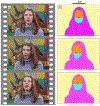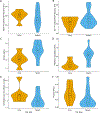Infant-directed song potentiates infants' selective attention to adults' mouths over the first year of life
- PMID: 36527322
- PMCID: PMC10276172
- DOI: 10.1111/desc.13359
Infant-directed song potentiates infants' selective attention to adults' mouths over the first year of life
Abstract
The mechanisms by which infant-directed (ID) speech and song support language development in infancy are poorly understood, with most prior investigations focused on the auditory components of these signals. However, the visual components of ID communication are also of fundamental importance for language learning: over the first year of life, infants' visual attention to caregivers' faces during ID speech switches from a focus on the eyes to a focus on the mouth, which provides synchronous visual cues that support speech and language development. Caregivers' facial displays during ID song are highly effective for sustaining infants' attention. Here we investigate if ID song specifically enhances infants' attention to caregivers' mouths. 299 typically developing infants watched clips of female actors engaging them with ID song and speech longitudinally at six time points from 3 to 12 months of age while eye-tracking data was collected. Infants' mouth-looking significantly increased over the first year of life with a significantly greater increase during ID song versus speech. This difference was early-emerging (evident in the first 6 months of age) and sustained over the first year. Follow-up analyses indicated specific properties inherent to ID song (e.g., slower tempo, reduced rhythmic variability) in part contribute to infants' increased mouth-looking, with effects increasing with age. The exaggerated and expressive facial features that naturally accompany ID song may make it a particularly effective context for modulating infants' visual attention and supporting speech and language development in both typically developing infants and those with or at risk for communication challenges. A video abstract of this article can be viewed at https://youtu.be/SZ8xQW8h93A. RESEARCH HIGHLIGHTS: Infants' visual attention to adults' mouths during infant-directed speech has been found to support speech and language development. Infant-directed (ID) song promotes mouth-looking by infants to a greater extent than does ID speech across the first year of life. Features characteristic of ID song such as slower tempo, increased rhythmicity, increased audiovisual synchrony, and increased positive affect, all increase infants' attention to the mouth. The effects of song on infants' attention to the mouth are more prominent during the second half of the first year of life.
Keywords: eye-tracking; infant-directed song; infant-directed speech; infants; language development.
© 2022 John Wiley & Sons Ltd.
Conflict of interest statement
Conflict of interest disclosure
WJ and AK are scientific consultants to and minority shareholders in EarliTec Diagnostics, Inc. EarliTec develops technology for early identification of autism and gives revenue to support treatment of children with autism. The activity has been reviewed and approved by Emory University’s Conflict of Interest Review Office. WJ and AK’s work with EarliTec is unrelated to the present paper.
Figures




References
-
- Ayneto A, & Sebastian-Galles N (2017). The influence of bilingualism on the preference for the mouth region of dynamic faces. Developmental Science, 20(1), e12446. - PubMed
-
- Bahrick LE, Lickliter R, & Flom R (2004). Intersensory redundancy guides the development of selective attention, perception, and cognition in infancy. Current Directions in Psychological Science, 13(3), 99–102.
-
- Bahrick LE, Walker AS, & Neisser U (1981). Selective looking by infants. Cognitive Psychology, 13(3), 377–390. - PubMed
Publication types
MeSH terms
Grants and funding
LinkOut - more resources
Full Text Sources

